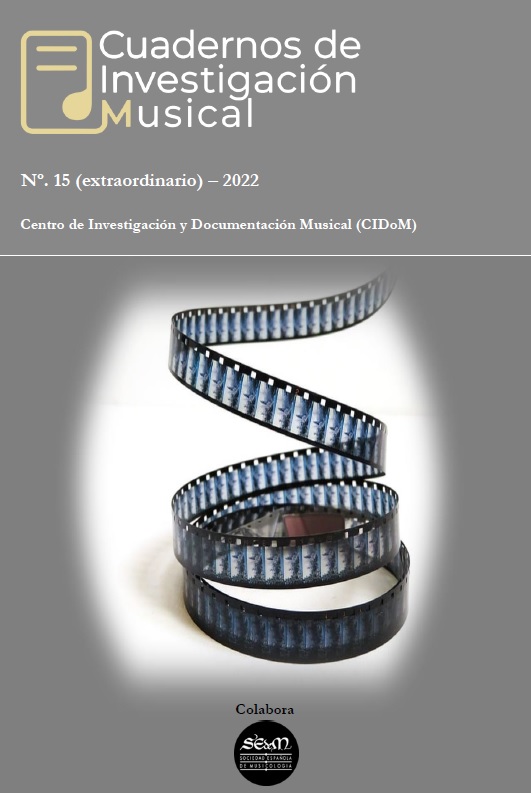The digital transition in the soundtrack music production in Spain
Main Article Content
Abstract
The production of music soundtracks is one of the most complex tasks carried out by the audio sector. It requires technicians, producers and musicians with different skills from conventional music production. In the last thirty years these processes have been altered by the digital revolution and the emergence of new concepts of recording studios. While the figure of the film composer is currently very popular, at the same time there is a lack of knowledge about how these musical productions are made. Furthermore, this period has produced a series of phenomena that have to do with the externalization of production to other places, which must be studied. In this text I will analyze how this transformation is taking shape, focusing on the audio sector in Spain.
Article Details
Los autores de los artículos mantienen el copyright, no recibirán ninguna contraprestación económica por el trabajo y el mismo siempre será reconocido como exclusivamente suyo. La revista se compromete a proteger la integridad y originalidad del artículo, así como los derechos de autor que correspondan. Los autores son los únicos responsables del material, textos e imágenes que utilizan en sus respectivos trabajos, debiendo respetar siempre los derechos de autor de terceras personas, por lo que la revista no se hace responsable de lo contenido en este tema respecto al trabajo de los autores.
References
Baños, Roque (2019, 1 diciembre). Scribd. Recuperado de https://es.scribd.com/article/437785718/Roque-Banos
Bell, A. P. (2015). DAW democracy? The dearth of diversity in ‘Playing the Studio’. Journal of Music Technology and Education, 8(2), pp. 129-146. doi: 10.1386/jmte.8.2.129
Bennett, S. (2018). Modern Records, Maverick Methods. New York: Bloomsbury Publishing Inc.
Clewes, R. (1997). Vangelis: Recording at Nemo Studios. Sound on Sound. Recuperado de https://www.soundonsound.com/people/vangelis-recording-nemo-studios
Fraile Prieto, T. (2010). Música de cine en España: Señas de identidad en la banda sonora contemporánea. Diputación: Departamento de Publicaciones: Festival Ibérico de Cine.
Frith, S. & Zagorski-Thomas, S. (2012). The Art of Record Production. Londres: Ashgate.
Hernando, D. Orquesta Sinfónica de Bratislava. BSO SPIRIT. Recuperado de http://www.bsospirit.com/reflexiones/bratislava.php
Juan de Dios, M. A. (2018). El auge de los estudios cinematográficos durante la Segunda República: una propuesta de análisis del diseño sonoro de El bailarín y el trabajador (1936). Cuadernos De ETNOmusicología - Dossier “Cine, Historia Y Banda Sonora”, 11, pp. 21-53.
Lacámara, I. (2020, 17 mayo). Entrevista con Iván M. Lacámara. AsturScore. Recuperado de https://asturscore.com/especiales/entrevista-con-ivan-m-lacamara/
Lasuén, S. (2018). La armonía en las bandas sonoras del cine español de los noventa. Madrid: Letra de Palo.
Lavengood, M. (2019). What Makes It Sound ’80s? Journal of Popular Music Studies, 31(3), 73-94. Recuperado de https://doi.org/10.1525/jpms.2019.313009
Leyshon, A. (2009). The Software Slump? Digital music, the democratization of technology, and the decline of the recording studio sector within the musical economy. Environment and Planning, 41(6), pp. 130-133.
Lluís i Falcó, J. (2010). The film composer in spain: the generation of '89. Music, Sound and the Moving Image, 4(2), pp. 225-235.
Moylan, W. (2009). Considering Space in Music. Journal on the Art of Record Production, 4. Recuperado de https://www.arpjournal.com/asarpwp/considering-space-in-music/
Théberge, P. (2012). The End of the World as We Know It: The Changing Role of the Studio in the Age of the Internet. En S. Frith & S. Zagorski-Thomas. The art of Record Production (pp. 77-90). Farnham: Ashgate.
Vinader, J. (2012). Musimagen entrevista... José Vinader. Musimagen. Recuperado de https://www.mans-paideia.com/musimagen-entrevista-a-jose-vinader/
Watson, A. (2015). Cultural Production in and Beyond the Recording Studio. New York: Routledge.
